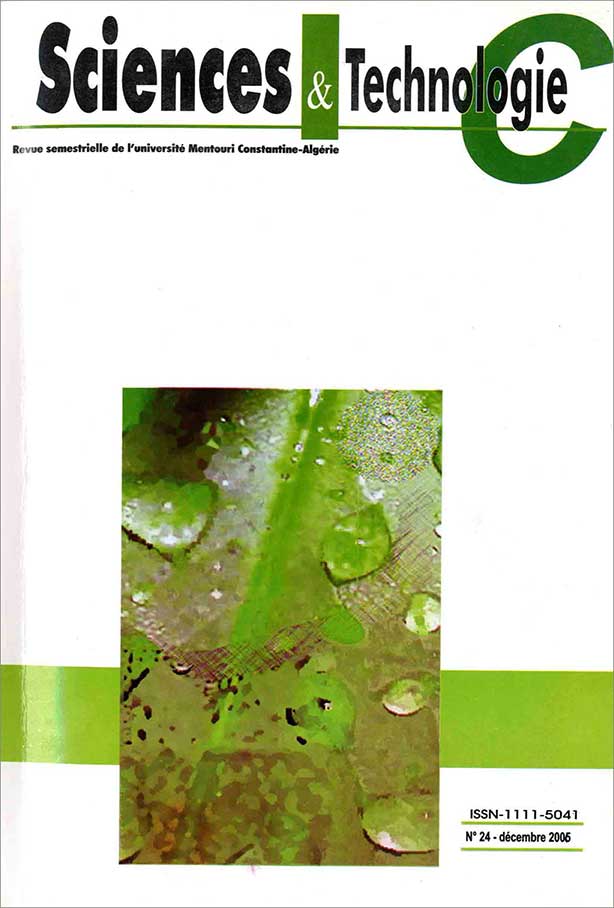LE CONTENU POLLINIQUE DE L’ATMOSPHERE DE LA VILLE D’EL HADJAR (ANNABA, ALGERIE)
Mots-clés :
Aéro-palynologie, Atmosphère pollinique, Méthode gravimétrique, Calendrier Pollinique, Données Météorologiques, PollinoseRésumé
The present work consists in analysing the pollen content of the atmosphere of the El-Hadjar city (Annaba, Algeria) in view to know the qualitative and quantitative composition of the pollens and to achieve a pollen calendar. Gravimetric method has been used during seven months (March-September 1997). A total of 7190 pollen grains belonging to 16 plant families have been taken. However, the Poaceae family, causing hay fever, has represented by 21 % in which were counted. The pollen calendar shows that the May is the richest month with a total of 2321 grains (32,28 %), followed by April with a 1748 grains. Data confrontation of the pollen spectrum with those of climatic conditions revealed a positive interrelationship between the numbers of pollen collected the increase of the temperature and the wind speed. On the other hand, the interrelationship was negative between the number of pollen, the precipitation and the relative humidity. The importance of the pollen calendar resides in the air concentration of the allergenic pollens according to the time, due to the allergenic point response of the pollinic allergens, expressed by allergenic pollen number in 24 hours.
Références
-Pons A. « Le pollen », Coll. Que sais-je ? Paris (1970),
p.
-Charpin J., Surinyach R. et Frankland A.W. « Atlas Européen des pollens allergisants ». Ed. Sandoz, (1974), 229p.
-Heim J. « Les relations entre les spectres polliniques récents et la végétation actuelleen Europe occidentale ». Univ. Cathol. Louvain, Lab. Paly. et Phyto., Louvain, (1970), 181p.
-Durham O.C. “The volumetric incidence of atmospheric allergens. IV. A proposed standard method of gravity sampling, counting and volumetric interpolation of results”. J. Allergy, Vol. 17 N° 2 (1946). pp. 79-86.
-Harrington J.B., Gill G.C. et Warr B.R. “ High efficiency pollen samplers for use in clinical allergy. J. Allergy, Vol. 30, (1959), pp. 357-375.
-Marx H.P., Spiegelman J. et Blumstein G.I. « An improved volumetric impinger for pollen counting. J. Allergy, Vol. 30 (1959),pp. 83-89.
-Ogden E.C., Raynor G.S., Hayes J.V., Lewis D.M. et Haines J.H. Manuel for sampling airborne pollen. Hafter press, New-York, 49-70, (1974).
-El-Gharbi B., Charpin H., Aubert J., Renard M., Mallea M. et Soler M. « Calendrier pollinique de Tunis ». Revue Franc. Allerg. Vol. 16 (1) (1976), 25-31.
-Chabert J. « Note sur le composant pollinique de l’air de Rabat (Maroc). Soc. Des. Sc. Nat. Du Maroc. Vol.51 (1971), 168-181.
-Kortebi H., Hammiche V., Lamrani Z., Abed L. ET Larbaoui D. « L’atmosphère pollinique d’Alger ». Bull. Soc. Hist. Nat. Afr. Nord. Vol. : 68 (3) (1977) 75-79.
-Malléa M et Soler M. Les méthodes de récolte pollinique. In : Atlas européen des pollens allergisants. Ed. Sandoz (1974), pp.11-18.
-Barthelemy L. “ Le prélèvement quantitative des pollens atmosphériques. Annales des Sciences Nat. et Bot. Paris, 13
ème Série, Tome 9 (1988), 63-66.
-Brandao R.M. et Lopes M.L. “Aerobiological studies and allergic dieases in Evora” (South of Portugal), 4th International conference on aerobiology. Sweden, August 27-31 (1990), pp. 27.
-Antepara I., Fernandez D., Combo P., Jauregui F et
Miguel A. “Pollen allergy in the Bilbao area (European atlantic seabord climate): Pollination forecasting methods”. Clanical and experimental allergy. Vol. 25 (1995) pp. 133-140.

